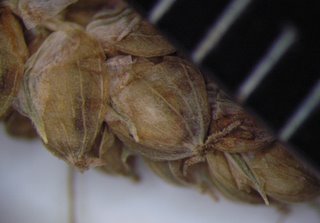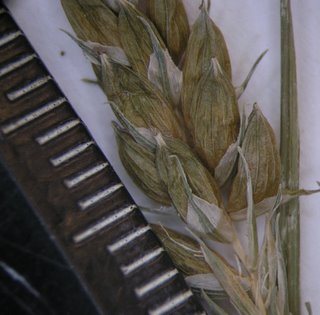Sedge Buster Lesson 10 - The End of Gynecandry
Yuckers! Man I hate cleanin' up dead stuff. Especially when its vaguely hominid. Jeez Louise, I hope the coroner don't come snooping around here.
But on to gynecandry, which may or may not be a real spell. We have concluded our review of the Porocystis sheets and our conclusion is "These three taxa probably should be treated as varieties of a single species C.caroliniana." Which is the same conclusion reached by D.S. Correll and M.C. Johnston back in the Stone Age. In fact, it's a quote. Nevertheless there seems to be just a bit of possible variation in our 14 sheets, we found another one, with some of the perygininia and achenes running to slightly different sizes. What we have been calling the C. bushii seems to run a bit bigger.
We have nothing here at the CB that would lead us to conclude that C. complanata exists in nature.
 Just for the heck of it, here's a picture of one we have been calling C. caroliniana. Note how little the spikelets are and the achene less than 2mm. Also, note those funny pistallate scales. Note the ends of the scales are sort of apiculate. However, and all that said, these may be smaller because they are a little immature.
Just for the heck of it, here's a picture of one we have been calling C. caroliniana. Note how little the spikelets are and the achene less than 2mm. Also, note those funny pistallate scales. Note the ends of the scales are sort of apiculate. However, and all that said, these may be smaller because they are a little immature.
 This next picture here somewhere is pretty cool. It shows most of a terminal spike of Carex davisii. See, the girls are on top and the male scales are way different in shape than the pistallate scales above them. All the lateral spikes on this species are on pedicels. And because the peryginias are big, averaging about 5mm, the pedicels sometimes droop a bit. This one, and C. oxylepisare both heaved into Section Hymenochlaenae by some of the especially learned.
This next picture here somewhere is pretty cool. It shows most of a terminal spike of Carex davisii. See, the girls are on top and the male scales are way different in shape than the pistallate scales above them. All the lateral spikes on this species are on pedicels. And because the peryginias are big, averaging about 5mm, the pedicels sometimes droop a bit. This one, and C. oxylepisare both heaved into Section Hymenochlaenae by some of the especially learned.
All righty then. What do ye want to pull next Ray?
Easy that Crumby, Section Lupilinae.
All righty then. Section Lupilinae is the upcomin'.
But on to gynecandry, which may or may not be a real spell. We have concluded our review of the Porocystis sheets and our conclusion is "These three taxa probably should be treated as varieties of a single species C.caroliniana." Which is the same conclusion reached by D.S. Correll and M.C. Johnston back in the Stone Age. In fact, it's a quote. Nevertheless there seems to be just a bit of possible variation in our 14 sheets, we found another one, with some of the perygininia and achenes running to slightly different sizes. What we have been calling the C. bushii seems to run a bit bigger.
We have nothing here at the CB that would lead us to conclude that C. complanata exists in nature.
 Just for the heck of it, here's a picture of one we have been calling C. caroliniana. Note how little the spikelets are and the achene less than 2mm. Also, note those funny pistallate scales. Note the ends of the scales are sort of apiculate. However, and all that said, these may be smaller because they are a little immature.
Just for the heck of it, here's a picture of one we have been calling C. caroliniana. Note how little the spikelets are and the achene less than 2mm. Also, note those funny pistallate scales. Note the ends of the scales are sort of apiculate. However, and all that said, these may be smaller because they are a little immature. This next picture here somewhere is pretty cool. It shows most of a terminal spike of Carex davisii. See, the girls are on top and the male scales are way different in shape than the pistallate scales above them. All the lateral spikes on this species are on pedicels. And because the peryginias are big, averaging about 5mm, the pedicels sometimes droop a bit. This one, and C. oxylepisare both heaved into Section Hymenochlaenae by some of the especially learned.
This next picture here somewhere is pretty cool. It shows most of a terminal spike of Carex davisii. See, the girls are on top and the male scales are way different in shape than the pistallate scales above them. All the lateral spikes on this species are on pedicels. And because the peryginias are big, averaging about 5mm, the pedicels sometimes droop a bit. This one, and C. oxylepisare both heaved into Section Hymenochlaenae by some of the especially learned. All righty then. What do ye want to pull next Ray?
Easy that Crumby, Section Lupilinae.
All righty then. Section Lupilinae is the upcomin'.

0 Comments:
Post a Comment
<< Home